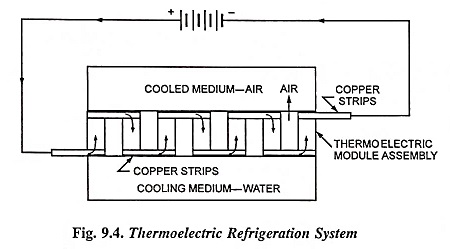Thermoelectric Refrigeration System Working:
Thermoelectric Refrigeration System works on the principle of Peltier effect according to which heat energy is evolved at one junction and absorbed at the other one when direct current is passed through a junction of two dissimilar metals like antimony and bismuth. It consists of a number of thermoelectric module assemblies in series joined by copper strips, as shown in Fig. 9.4. Each thermoelectric module is built up of a large number of thermoelectric couples.
When the direct current is passed through the thermoelectric module assemblies in the direction shown in Fig. 9.4, junctions at the top of the assembly are cooled and those at the bottom are heated up. Thus top junctions abstract heat from the surroundings and produce refrigerating effect and bottom junctions require cooling by water. Module assembly, therefore, abstracts heat from the medium at top and rejects the same to the medium at bottom.
If the direction of flow of current is reversed, heat production at the junctions is reversed, i.e., now bottom of the modules will be cooled and top ones get heated up. If it is an air conditioner, air will get heated up instead of getting cooled. Thus summer and winter operating of air conditioner can easily be obtained just by reversing the direction of flow of current.
Advantages:
The main advantages of this thermoelectric refrigeration system are absence of moving parts and ease of automatic control by controlling the magnitude of current.
Disadvantages:
The only drawback of this system of refrigeration is its very high initial cost.
